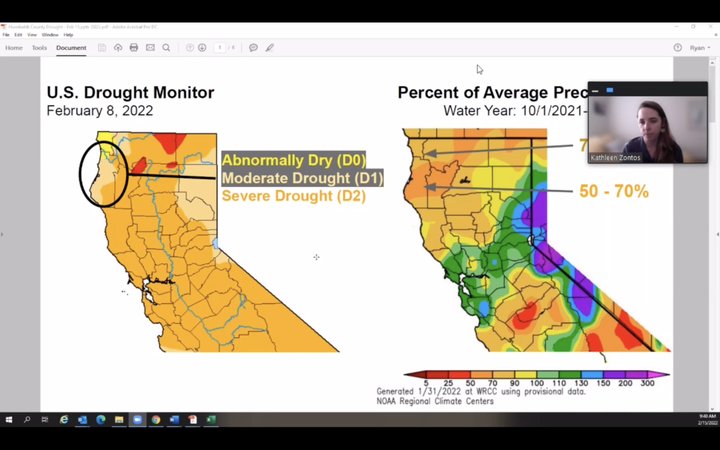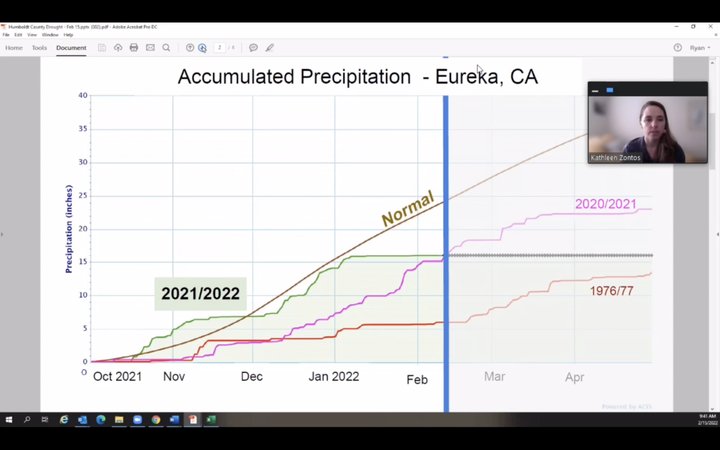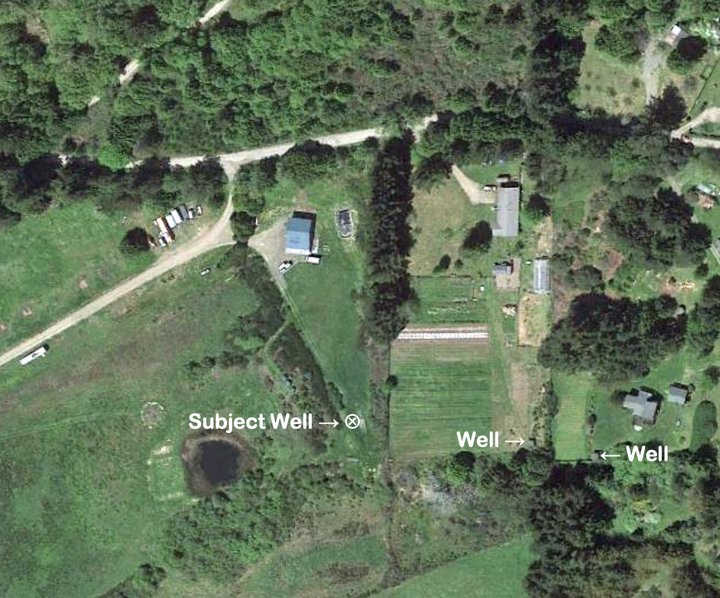Kathleen Zontos, a hydrologist with the National Weather Service’s Eureka office, delivers a presentation on current drought conditions at Tuesday’s meeting of the Humboldt County Board of Supervisors. | Screenshot.
###
Humboldt County hasn’t seen any significant rainfall since early January, and according to Kathleen Zontos, a National Weather Service hydrologist who addressed the ongoing drought at Tuesday’s Board of Supervisors meeting, if the next two and a half months remain dry, Northern California may wind up having the driest three-year period on record.
“So we’re kind of coming into the 11th hour as far as reaching where we want to be,” Zontos told the board.
The board voted to continue the ongoing state of local emergency at Tuesday’s meeting, following the advice of staff with the Office of Emergency Services and the Humboldt County Drought Task Force.
Yana Valachovic, a forest scientist with the University of California Cooperative Extension, said animal agriculture operations across the western United States are seeing high demand and limited supply of hay, alfalfa and other products. Many local and regional producers have reduced the size of their herds due to such drought-related challenges, she said, noting that last year’s relatively cold spring also slowed grass growth.
As you can see from the chart below, Eureka experienced a strong start to the water year, which runs from October 1 to the end of September, but precipitation flatlined shortly after the New Year.
The green line represents the current water year, with pink showing last year’s rainfall and red showing the driest year on record. | Screenshot.
###
Much of the meeting’s drought discussion wound up focusing on cannabis. Staff asked the board to decide whether irrigation water for permitted weed grows, including the permitting of wells, should be curtailed. The board also considered creating a new position of resiliency coordinator for the Drought Task Force.
Planning and Building Director John Ford said staff wasn’t recommending curtailment action just yet, in part because the outlook for summer will grow clearer in the coming months. Staff in his department has been working with consultants to analyze the cumulative impacts of permitted wells on surface water, though at the moment permit applications are still being considered on a case-by-case basis in consultation with hydrogeologists.
Second District Supervisor Michelle Bushnell noted that there’s talk in the community about wells running dry but little in the way of confirmation.
“When we’re processing applications, nobody really wants to admit that a well has run dry,” Ford said.
Third District Supervisor Mike Wilson later noted that local residents are reporting dry wells to their well drillers, if not to county permitting authorities.
During the public comment period, a number of cannabis folks argued that the industry is being unfairly singled out, and they urged the board not to enact any irrigation curtailment measures.
“Cannabis water use is more regulated, measured and tracked than any other agricultural industry and uses significantly less water than any other industry,” said Natalynne DeLapp, executive director of the Humboldt County Growers Alliance (HCGA), a cannabis industry group. Her organization supports increased water storage capacity but is waiting for the state to release funds for that endeavor, she said.
Ross Gordon, the HCGA’s policy director, said the state needs to allow for fallowing of cannabis farms during dry years, letting cultivators cut back on their production without permanently forfeiting their license. He urged the board to advocate for that at the state level.
After the public spoke, Ford said the focused discussion on cannabis operations was not so much about singling the industry out for extra scrutiny; rather, it’s about clearly communicating regulatory issues.
“We are in a place where we need to know, what is the effect of wells? Are they hydrologically connected to surface water,” Ford said. “There’s been a lot of struggle with questions as to whether adequate investigation has been done. Really, it’s a prudent approach to make sure we’re not approving things without adequate information.”
As for the proposed resiliency coordinator position, Mario Kalson, supervising environmental health specialist with the county, said staff and the board need to consider both the scope of the role and potential sources of funding. Locating the job within the Office of Emergency Services could open up emergency mitigation funding and grant opportunities, Kalson explained. Staff plans to bring the matter forward for more discussion next month.
Modified Google Earth imagery of property near Petrolia where Humboldt’s Own, LLC, plans nearly 65,000 square feet of cannabis cultivation. | Via a county staff report.
###
The real drama in Tuesday’s meeting came later in the morning as the board considered an appeal of a Planning Commission decision to require a second water source as a condition of approving 64,800 square feet of commercial cannabis cultivation near Petrolia by Humboldt’s Own, LLC.
Ford explained that the question at hand was whether the existing well on the property might be hydrologically connected to nearby wells, wetlands or surface waters including Mill Creek.
Certified Engineering Geologist David Lindberg had assessed the well and submitted a letter with his conclusion:
“In our opinion, the subject well is not hydrologically connected to, or influencing surface water flows or nearby wells, Mill Creek tributaries, or ephemeral wetlands,” the letter states. He submitted a follow-up letter to county staff last week, reasserting his finding that the well is “hydrologically isolated” from surface waters and wetlands.
Lindberg was on hand via Zoom to answer questions from the board, and Madrone certainly did.
The exchange started politely enough, with Madrone asking Lindberg about his credentials, including whether or not he’d obtained his master’s degree, as Madrone himself did. But the Fifth District supervisor quickly transitioned to a more confrontational approach, like an attorney cross-examining a witness on the stand.
Referring to Lindberg’s recent letter to the county, Madrone said, “You’ve got a statement in there that says — it’s in the first paragraph and it says, ‘Note the water surface of the river is approximately equivalent to the depth of the well.’ Do you still stand by that statement?”
Lindberg confirmed that he did. Madrone then proceeded to challenge that conclusion, running through measurements and geological descriptions from in the letter and saying that, based on Lindberg’s own information, the bottom of the well must be 20 feet deeper than the surface of the Mattole River, some 3,200 feet to the south.
“So I find it very difficult to understand how, number one, you can make a false statement … ,” Madrone said. “I don’t see any evidence in this report that can substantiate that this bottom 20 feet of this well is not tapping into the aquifer of the river. I realize it’s 3000 feet away, but these aquifers can be extremely expansive, as we’ve seen in all of our books that we studied when we went to school. The water in the river doesn’t just end at the banks of the river.”
Board Chair Virginia Bass asked Madrone if he’d reached out to Lindberg ahead of the meeting to address these issues, “because it feels like we’ve got a game of ‘gotcha’ going here, and it bothers me.”
Madrone said he had not reached out to Lindberg earlier because he wanted to have an unbiased opinion when he considered the matter.
“And so, no, I didn’t reach out,” Madrone said, “and there’s nothing wrong with that. In fact, that’s really the appropriate way to behave in these situations. And Mr. Lindberg has every opportunity here, today, to respond to this. And he had an opportunity with the letter that he submitted, and his letter simply has false information in it.”
Bass said Lindberg should be given a chance to respond to the accusations, and Madrone bristled.
“They’re not — Madam Chair, they’re not accusations,” he said.
“There were some comments made,” she countered.
“I don’t appreciate you couching my input as accusations,” Madrone said. “I presented information that is based on factual information presented by Mr. Lindberg. They’re not accusations, please.”
Lindberg said he didn’t know where to even begin responding. He went on to describe the area’s geology, saying the Mattole river is eroded into a channel of Franciscan bedrock while the well to the north taps into sandstone. He sounded flustered as his telephone rang in the background and an answering machine message played.
Finally he said, “It’s hard for me to visualize any way that the drawdown of the well expands the cone of depression from which it draws 3,200 feet away to the river. It just seems like quite a stretch of the imagination.”
“Well, my question didn’t get answered,” Madrone said. He ran through his analysis of the figures again. “The facts suggest that the well is drilled 20 to 40 feet below the surface of the river, not equal to it. And you didn’t answer that question.”
“I said it was approximately equivalent to [the river level],” Lindberg said.
“Yes, but it’s not,” Madrone said. “It’s 20 to 40 feet deeper than. That’s not ‘approximately equivalent to.’”
“We have a difference of opinion, I guess, on what ‘approximately equivalent’ means at this scale,” Lindberg said.
Bushnell then cut in, asking Ford to reiterate what exactly the board was supposed to be considering. She said applicants are required to conduct due diligence on matters such as this hydrology question, and that’s exactly what this letter represents.
“If you accept the report, yes,” Ford said. He went on to ask Lindberg to corroborate his understanding of the science — namely, that the water that flows into the Mattole goes along the top of the Franciscan layer while the well likely pulls from a deeper, isolated aquifer in a more permeable layer of fractured sandstone.
Lindberg said that was indeed his conclusion, but Madrone was not appeased. He said there’s still “zero information” about the geologic layers between the well’s location and the banks of the river. The board should not approve this project without substantial evidence that the well is not pulling from river’s aquifer, he argued, because the salmon and steelhead populations there are threatened and endangered.
“The river goes low, these fish need this water,” he said. “We as a board are supposed to look to the larger issues within our community and not just special interests.”
Bohn asked Ford whether the county has ever required an applicant to have test wells dug between their well and a river to study the underlying geology. Ford said no.
Senior Planner Cliff Johnson said the applicant, Jason Goforth, has 75,000 gallons of water storage onsite and is willing to provide more if he can get the necessary funding. Goforth, via phone, said he just can’t afford it right now.
Bushnell asked a few questions of staff and the applicant, and then she offered an apology “for the hostility on this board,” an apparent reference to Madrone’s interrogation. “It made me super uncomfortable. I just have to say that. I understand everybody wants to make their point, but I am not very comfortable with it.”
Bass said she had tried to steer away from the hostility but it wasn’t working so well.
During the public comment period, cannabis project consultant Steve Breitenstein said that while he appreciates the value of healthy debate, “the implications of this discussion extend well beyond the specific appeal… .” Many of his clients have been frustrated by the county’s lack of clarity on water sourcing requirements.
“Most of my clients are not hydrologists or engineering geologists; they’re farmers,” he said. “They rely on — and pay substantial amounts of money to — qualified professionals for assessments and have no choice but to trust their findings.” The Planning Commission seemed to base its approval on those findings as well, he said, but now Madrone had offered a second opinion. The county should have clear guidelines, Breitenstein argued.
“That’s the only way to avoid the repetition of this exercise for dozens and dozens of future projects. I alone have at least 10 different clients who are awaiting hearings on wells, and I have no idea what to tell them. Should we hire a geologist? Should we hire two? Should we consult with Supervisor Madrone?”
When the matter came back to the board, Madrone defended himself, noting that he’s a subject matter expert, not only in regards to hydrology and water but also fisheries in the Mattole.
“And, you know, calling it ‘hostile’ or ‘accusations’ I find to be really disrespectful,” he said. “You can call it ‘passionate.’ I would accept that. I am very passionate about protecting our fisheries and our fishing industry on the Mattole River. Yes, very passionate. But I was not hostile.”
He said his initial questions still hadn’t been answered to his satisfaction. “And it would seem to me that my other supervisors don’t seem to think that’s important, you know, and they’re willing to just write that off,” he said. “I find that to be really just amazing to me, and frankly a violation of our code of conduct that says we’re supposed to look out for the greater community interest, not just for a special interest. I think that’s really what’s going on here. And that’s not meant to be an accusation or be hostile. I’m just making my statements.”
He went on to suggest that applicants would be better off spending their money on rainwater catchment systems, which the Planning Commission readily approves, rather than expensive consultants.
While the discussion had been tense, that latter comment served to illuminate a path forward. Bushnell noted that the applicant had already stated a desire to provide more storage. She did take issue with Madrone’s suggestion that she and the other supervisors were catering to a special interest at the expense of greater community interests. She said she was merely trying to follow the rules of the county’s cannabis ordinances.
Wilson said he appreciated where the Planning Commission was coming from by encouraging water storage.
Eventually, the board landed on common ground, opting to approve the applicant’s appeal while requiring them to get the Planning Commission’s additional water storage in place by 2025.
Madrone commended the board in the end, saying they’d landed on a good compromise.





CLICK TO MANAGE